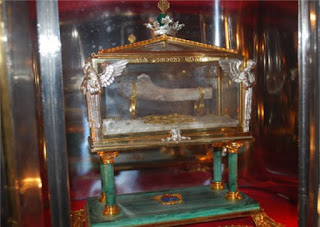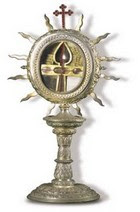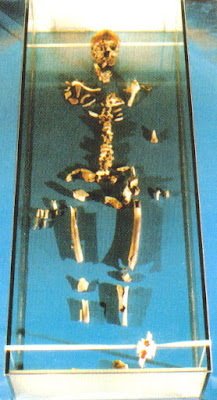 I was curious if there were some relics of our guild patron saint Thomas spread over Europe (or India). The answer is yes - and, surprisingly, there is an almost complete skeleton of him! The story is that after Saint Thomas was slain, he was initially buried in India. In the 3rd century, however, his bones were transported to Edessa in Mesopotamia (the place from the feast with the hand of the cupbearer) by the Indian King Mazdai (Misdeus), where a tomb was build for him. In 13th century the bones were 'rescued' together with the tombstone to Italy, as the shrine with the bones was threatened by the Turks. The relics made an intermediate stop at the island of Chios in the Aegean. From there they were stolen by Leone Acciaiuoli, captain of a ship from the fleet of Manfred, prince of Taranto, and taken to Ortona in Italy were they arrived on 6 September 1258. In Ortona, the relics were kept in the basilica San Thomasso Apostolo, which was desecrated by the Turks in 1566. After this event the remains were kept in an gild copper urn that was made in 1612 by Tommaso Alessandrini from Ortona.
I was curious if there were some relics of our guild patron saint Thomas spread over Europe (or India). The answer is yes - and, surprisingly, there is an almost complete skeleton of him! The story is that after Saint Thomas was slain, he was initially buried in India. In the 3rd century, however, his bones were transported to Edessa in Mesopotamia (the place from the feast with the hand of the cupbearer) by the Indian King Mazdai (Misdeus), where a tomb was build for him. In 13th century the bones were 'rescued' together with the tombstone to Italy, as the shrine with the bones was threatened by the Turks. The relics made an intermediate stop at the island of Chios in the Aegean. From there they were stolen by Leone Acciaiuoli, captain of a ship from the fleet of Manfred, prince of Taranto, and taken to Ortona in Italy were they arrived on 6 September 1258. In Ortona, the relics were kept in the basilica San Thomasso Apostolo, which was desecrated by the Turks in 1566. After this event the remains were kept in an gild copper urn that was made in 1612 by Tommaso Alessandrini from Ortona.From the 17th century to today, the shrine has been opened several times to do some surveys (which bones are there) and even some research. Between 1983-1986, the shrine was opened for a protection and preservation project. The opportunity was also taken to do some scientific research on the bones of the apostle. This was done under supervision of prof. dr. Arnaldo Capelli, prof. dr. Sergio Sensi, prof. dr. Luigi Capasso (paleopathology) and prof. dr. Fulvio Della Loggia, all from the Faculty of medicine from the University of Chieti. The anthropological examination on the remains of the skeleton established that the bones belonged to a relatively long male individual with delicate bone structure, with a height of 1 metre 60 cm plus/minus 10 cm. At the age of death the individual was between 50 and 70 years old, with a fracture of the right cheekbone caused by a sharp blow shortly before or after death. The person did also suffer from rheumatism or artritis, which could be seen at the small joints of the hands. Furthermore, a small osteoma (bone tumour) was found in the frontal region of the skull.

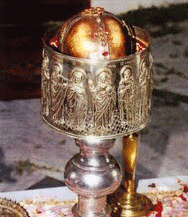
Other Thomas artefacts
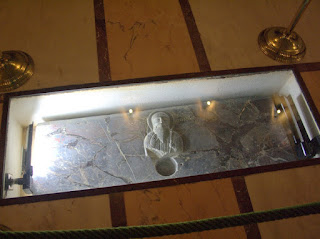 Some other artefacts related to St. Thomas are his tombstone, which made the same trip from Edessa to Ortona as the skeleton, and also resides in the Basilica San Thomasso Apostolo. The tombstone measures 137 by 48 cm and has a thickness of 48 cm and is made of chalcedone. This tombstone is actually a plaque used to cover a tomb made of lower quality material, a practise used in early Christian times. The plaque has an inscription and a bas-relief that similar to those in the Syrian Mesopotamian area (i.e. where Edessa is situated). The inscriptions are in Greek unicals and are dated from the 3rd to 5th century and mention 'thomas osios' (holy Thomas or Saint Thomas). More careful study of the inscription found some traced signs over the words, which would change the meaning slightly to that of 'the real Thomas'. The bas-relief depicts a religious figure with a halo in the act of imparting, with the right hand, the blessing (according to the rites of the Eastern Church and indicating the first two letters, in Greek, of the word Christ). In the left hand he holds an object that could be a sword, which is a clear reference to the martyrdom of Saint Thomas. The lower part of the stone has two holes of different sizes, such as those found in various tombs of the early centuries of Christianity, in order to introduce balms or make libations on the grave of the deceased. When it came to the tomb of a martyr, the broader was also used to provide relics from contact.
Some other artefacts related to St. Thomas are his tombstone, which made the same trip from Edessa to Ortona as the skeleton, and also resides in the Basilica San Thomasso Apostolo. The tombstone measures 137 by 48 cm and has a thickness of 48 cm and is made of chalcedone. This tombstone is actually a plaque used to cover a tomb made of lower quality material, a practise used in early Christian times. The plaque has an inscription and a bas-relief that similar to those in the Syrian Mesopotamian area (i.e. where Edessa is situated). The inscriptions are in Greek unicals and are dated from the 3rd to 5th century and mention 'thomas osios' (holy Thomas or Saint Thomas). More careful study of the inscription found some traced signs over the words, which would change the meaning slightly to that of 'the real Thomas'. The bas-relief depicts a religious figure with a halo in the act of imparting, with the right hand, the blessing (according to the rites of the Eastern Church and indicating the first two letters, in Greek, of the word Christ). In the left hand he holds an object that could be a sword, which is a clear reference to the martyrdom of Saint Thomas. The lower part of the stone has two holes of different sizes, such as those found in various tombs of the early centuries of Christianity, in order to introduce balms or make libations on the grave of the deceased. When it came to the tomb of a martyr, the broader was also used to provide relics from contact. Modern science
And you could also use 3-D forensic facial reconstruction techniques to shape the face of Thomas in clay...
Sources used:
Website of the Basilica San Thomasso Apostolo.The website of Keith Hunt on Doubting Saint Thomas in India
And many other internet sources, including some utterly confusing Indian ramblings on St. Thomas.










